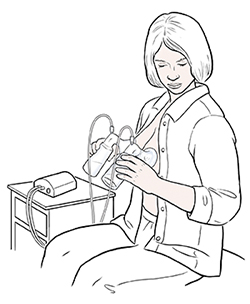A
B
C
D
E
F
G
H
I
J
K
L
M
N
O
P
Q
R
S
T
U
V
W
X
Y
Z
Topic IndexLibrary Index
Click a letter to see a list of conditions beginning with that letter.
Click 'Topic Index' to return to the index for the current topic.
Click 'Library Index' to return to the listing of all topics.
Expressing Your Milk
Work, school, or even a late-night movie can require you to be away from your baby. This doesn't mean you have to give up breastfeeding. Feeding your baby from your breasts is ideal. If you must be away from your baby, you can express milk from your breast. Talk with your healthcare provider about the best ways to feed expressed breastmilk to your infant. But remember, don’t give your baby bottles or pacifiers until they are about 4 to 6 weeks old, unless needed sooner for health reasons. This helps you both get a good start on breastfeeding. Your baby can get used to your natural nipple first.
Always wash your hands before expressing milk from your breast.
Ideas to stimulate letdown
-
Hold a washcloth under very warm water and wring it out.
-
Place a warm washcloth over each breast to warm them.
-
Gently massage your breasts to stimulate the milk flow.
-
Start under the arm and move around the entire breast.
-
Apply steady pressure on areas of milk in the breast by pressing fingers in a C hold gently back toward the chest, not toward the nipple. While applying gentle pressure on the breast inward, press thumb and finger pads together (pushing in, not pulling out toward the nipple). Find a good rhythm of press and relax, like a baby’s suckling rhythm.
-
If you’re away from your baby, looking at your baby’s picture can help your milk letdown.
Expressing by hand or pump
Your lactation consultant can help you choose the best method for your needs. Here are some tips:
-
Expressing by hand reduces pressure in swollen or leaky breasts. It may be a good way to start a pumping session. If you need to give expressed milk to your baby in the first few days after delivery, hand expression can often help get more colostrum than using a pump. Ask your nurse, lactation consultant, or your healthcare provider to teach you how to hand express.
-
Start expressing your milk within the first hour after birth if able, and definitely within 6 hours of separation from your baby in the hospital.
-
When separated from your baby, it's best to express as often as a baby would breastfeed. Newborns feed 8 to 12 times each 24 hours.
-
A pump gently pulls your nipple into the cup like a baby’s suck and can be the fastest way to express after your milk comes in. Pumps come in manual, battery-operated, and electric styles. To protect your breasts and the milk you pump, follow the directions that come with your pump. If your pump is not comfortable, look for a lactation consultant to help with the correct fit and use.
-
For sick or premature babies who aren't feeding at the breast, "hands-on pumping" is a special way to help be sure you make enough milk. Hands-on pumping involves a combination of both hand expression and an electrical pump.
-
Hand expressing while using a pump can increase the amount of milk you can pump. It can also increase the fat content of the pumped milk.
-
Many insurances cover a breast pump if you are expecting or have delivered a baby. You can also buy or rent a pump from a drugstore or medical equipment store. Check with your hospital to find out where you can buy or rent a pump.
 |
| Expressing by hand. |
 |
| Expressing with double pump. |
Working and breastfeeding
-
Breastfeed your baby all the time during your maternity leave. This helps set up your milk supply for the whole year.
-
When your baby is about 2 to 4 weeks old, consider starting to pump on occasion after you feed the baby. It will help you build a supply for going back to work. You can freeze this expressed milk. Be sure to put the date on the container. Feeding at the breast plus pumping will help your breasts make more milk. It's possible to make too much milk, so get guidance on how to fit pumping into your breastfeeding schedule if you have questions. Feeding your baby from your breasts is ideal. If you must be away from your baby, you can express milk from your breast. Talk with your healthcare provider about the best ways to feed expressed breastmilk to your infant.
-
Express milk during work breaks. This helps protect your milk supply. It also helps prevent engorged or leaking breasts.
-
Arrange to breastfeed at lunch if your childcare is nearby. If not, be sure to pump during your lunch break.
-
Breastfeed before you leave for work and soon after you return home. Your partner may be able to make dinner while you feed the baby.
-
Breastfeed at night and on weekends. This will keep up your milk supply.
Online Medical Reviewer:
Donna Freeborn PhD CNM FNP
Online Medical Reviewer:
Heather M Trevino BSN RNC
Online Medical Reviewer:
Michele Burtner CNM
Date Last Reviewed:
10/1/2022
© 2000-2024 The StayWell Company, LLC. All rights reserved. This information is not intended as a substitute for professional medical care. Always follow your healthcare professional's instructions.